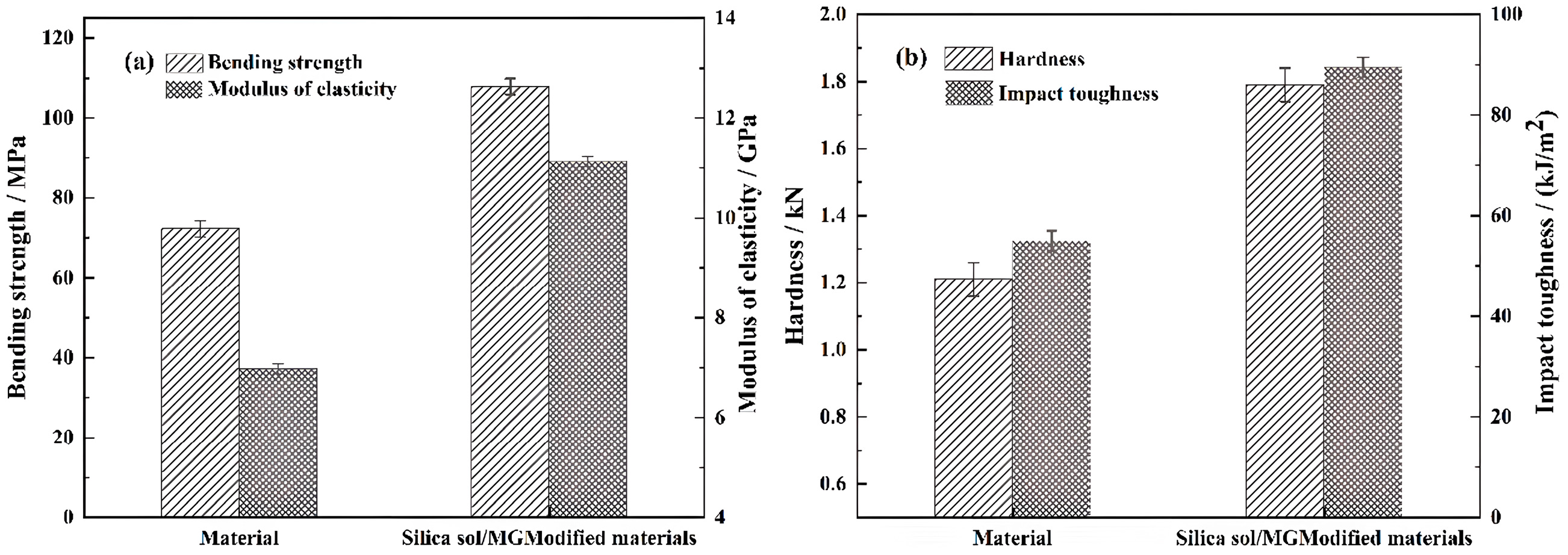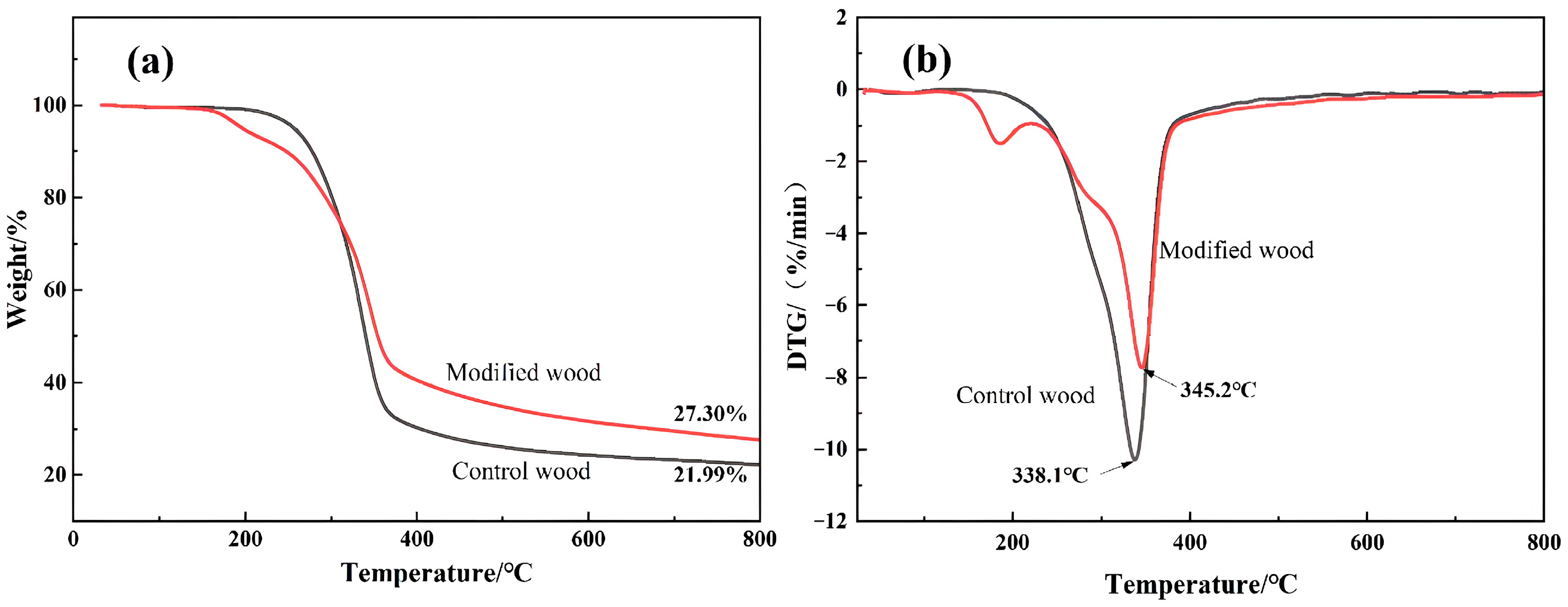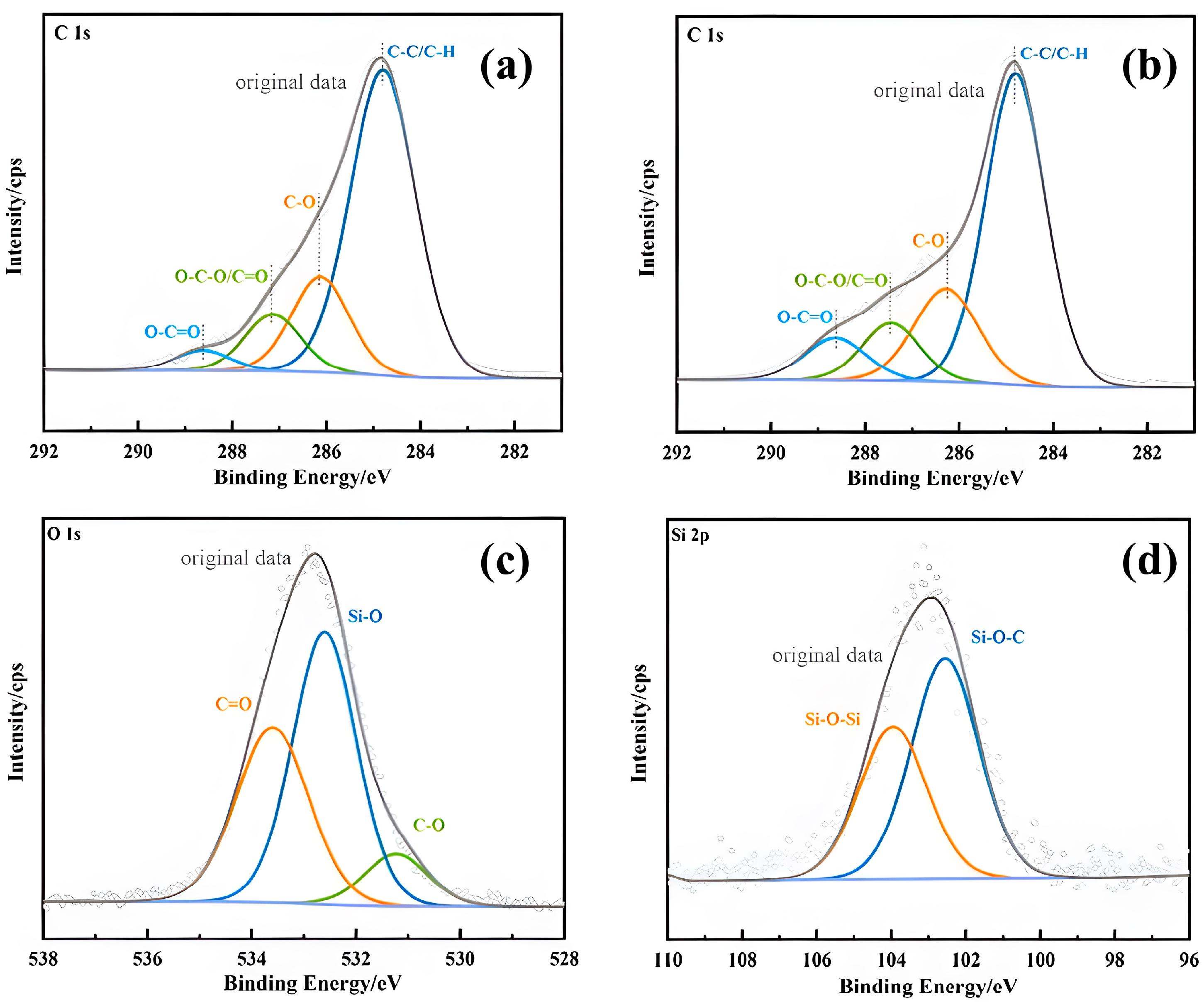Study on Modification of Poplar Wood via Composite Impregnation with Silica Sol/Melamine–Glyoxal Resin
Abstract
:1. Introduction
2. Materials and Methods
2.1. Sample Preparation
2.1.1. Materials
2.1.2. Preparation of Modified Silica Sols
2.1.3. Preparation of Silica Sol/MG Resin Composite Modifier
2.1.4. Preparation of Silica Sol/MG Resin-Modified Poplar
2.2. Testing Instruments
2.3. Performance Testing and Characterization
2.3.1. Weight Percent Gain
2.3.2. Density, Water Absorption (WA), and Dimensional Stability Tests
2.3.3. Mechanical Performance Testing
2.3.4. SEM Inspection
2.3.5. TG-DTG Testing
2.3.6. FT-IR Detection
2.3.7. XPS Detection
3. Results and Discussion
3.1. Comparative Analysis of Physical and Mechanical Properties of Poplar and Modified Poplar
3.2. Effect of Silica Sol/MG Resin Modification on the Micromorphology of Poplar Wood
3.3. Effect of Silica Sol/MG Resin Modification on the Thermal Stability of Poplar
3.4. Effect of Silica Sol/MG Resin Modification on the Chemical Structure of Poplar
3.4.1. FT-IR Analysis
3.4.2. XPS Analysis
4. Conclusions
- (1)
- Comparative analysis of the properties between poplar and modified poplar revealed improvements in the physical and mechanical properties of silica sol/MG resin-modified poplar compared to the unmodified poplar. Moreover, the mechanical properties displayed a consistent linear growth trend. Compared with the poplar, the density of silica sol/MG resin-modified poplar increased, and the water absorption rate decreased. In addition, the MOR, MOE, hardness, and impact toughness increased by 49.25%, 59.46%, 47.93%, and 62.73%, respectively. Combining the impact damage cross-sectional profiles of the poplar and the silica sol/MG resin-modified poplar, it can be concluded that the impact toughness of the wood improved the most after the composite impregnation modification;
- (2)
- SEM observation showed that the cell cavities, cell interstices, and cell wall pores of the modified poplar were covered and filled by the compound modifier, and the filling effect was good;
- (3)
- The results of TG-DTG analysis showed that the maximum pyrolysis temperature of the modified poplar was 345.2 °C, which increased by 7.1 °C compared with the poplar, and the residual char rate of poplar wood increased from 21.99% to 27.30%, indicating that the impregnation treatment improved the thermal stability of the wood;
- (4)
- FT-IR and XPS results showed that the silica sol/MG resin composite modifier was physically filled into the wood and chemically bonded with the main components of the wood cell wall. The increased oxygen-containing functional groups in the modified wood and the appearance of Si-O-C bond peaks confirmed that the silica sol/MG resin composite modifier was chemically cross-linked with the internal wood components. It was further validated by the increase in oxygen-containing functional groups and the appearance of Si-O-C bond peaks in the modified poplar, confirming the chemical cross-linking with the internal wood groups. The penetration of the silica sol/MG resin modifier into the wood and the cross-linking and curing increase the structural resistance of the wood to external forces, thus improving the dimensional stability and mechanical properties of poplar wood.
Author Contributions
Funding
Institutional Review Board Statement
Data Availability Statement
Conflicts of Interest
References
- Zelinka, S.; Altgen, M.; Emmerich, L.; Guigo, N.; Keplinger, T.; Kymäläinen, M.; Thybring, E.E.; Thygesen, L.G. Review of Wood Modification and Wood Functionalization Technologies. Forests 2022, 13, 1004. [Google Scholar] [CrossRef]
- Wu, Y. Newly advances in wood science and technology. Zhongnan Linye Keji Daxue Xuebao 2021, 41, 1–28. [Google Scholar]
- Xue, J.; Xu, W.; Zhou, J.; Mao, W.; Wu, S. Effects of High-Temperature Heat Treatment Modification by Impregnation on Physical and Mechanical Properties of Poplar. Materials 2022, 15, 7334. [Google Scholar] [CrossRef]
- Dong, Y. Performance and Enhancement Mechanism of Cell Wall Modification of Fast-Growing Poplar Wood. Ph.D. Thesis, Beijing Forestry University, Beijing, China, 2018. [Google Scholar]
- Yang, Y.; Zhang, L.; Song, F.; Zhang, J.; Zhang, Z. Research Progress on High Value Utilization of Fast-growing Wood in Plantation. China For. Prod. Ind. 2020, 57, 53–55. [Google Scholar]
- Xu, K.; Zhang, X.; Li, Z.; Zhou, C.; Lv, J.; Li, X.; Wu, Y. Research Progress of Wood Low Molecular Weight Resin Impregnation Modification and Its Drying. Cailiao Daobao 2022, 36, 223–229. [Google Scholar]
- Wang, F.; Liu, J.; Lv, W.; Chai, Y. Research process on resin impregnation multifunctional modification of wood. For. Grassl. Mach. 2017, 28, 43–47. [Google Scholar]
- Gao, Y.; Li, Y.; Ren, R.; Li, L.; Chen, Y. Enhanced mechanical and humidity resistance properties of heat-treated wood by impregnation of low-molecular-weight lignin. Wood Sci. Technol 2022, 56, 1551–1565. [Google Scholar] [CrossRef]
- Sun, Z.; Zhang, Y.; Zuo, Y.; Wu, Y.; Wang, Z.; Lv, J. Research Status and Prospect of Organic-Inorganic Compound Modified Fast-growing Wood. Cailiao Daobao 2021, 35, 5181–5187. [Google Scholar]
- Xu, J.; Qin, Y.; Liu, R.; Long, L.; Ma, E. Preparation and properties of high-performance fast-growing wood modified by exfoliated organo-montmorillonite in waterborne hyperbranched polyacrylate emulsion. Constr. Build. Mater 2021, 298, 123868. [Google Scholar] [CrossRef]
- Chen, J.; Wang, S.; Du, X. Advances in Epoxy/two-dimensional Nanomaterial Composites. Cailiao Daobao 2021, 35, 17210–17217. [Google Scholar]
- Liu, J.; Zhang, J.; Gan, W.; Mo, H. Research Progress on Sugar-based Melamine Formaldehyde Resin as Wood Adhesives. Cailiao Daobao 2023, 37, 276–282. [Google Scholar]
- Chen, H.; Li, X.; Chen, M.; He, Y.; Zhao, H. Self-cross-linked melamine-formaldehyde-pectin aerogel with excellent water resistance and flame retardancy. Carbohydr. Polym. 2019, 206, 609–615. [Google Scholar] [CrossRef] [PubMed]
- Yan, Y. Study on Performance and Enhancement Mechanism of Glyoxal Compound Modified Fast-Growing Poplar Wood. Ph.D. Thesis, Beijing Forestry University, Beijing, China, 2017. [Google Scholar]
- Qin, Z.; Zhang, Y.; Liu, M.; Li, C. Preparation and properties of silica sol/melamine glyoxal resin. Des. Monomers Polym. 2023, 26, 15–22. [Google Scholar] [CrossRef] [PubMed]
- Kan, Y.; Sun, B.; Kan, H.; Bai, Y.; Gao, Z. Preparation and characterization of a melamine-urea-glyoxal resin and its modified soybean adhesive. Int. J. Adhes. Adhes. 2021, 111, 102986. [Google Scholar] [CrossRef]
- GB/T 1927.5-2021; Test methods for physical and mechanical properties of small clear woodspecimens—Part 5: Determination of density. Standardization Administration of the Peopleʹs Republic of China: Beijing, China, 2021.
- GB/T 1927.7-2021; Test methods for physical and mechanical properties of small clear woodspecimens—Part 7: Determination of water absorption. Standardization Administration of the Peopleʹs Republic of China: Beijing, China, 2021.
- GB/T 1927.8-2021; Test methods for physical and mechanical properties of small clear woodspecimens—Part 8: Determination of swelling. Standardization Administration of the Peopleʹs Republic of China: Beijing, China, 2021.
- GB/T 1927.9-2021; Test methods for physical and mechanical properties of small clear woodspecimens—Part 9: Determination of bending strength. Standardization Administration of the Peopleʹs Republic of China: Beijing, China, 2021.
- GB/T 1927.10-2021; Test methods for physical and mechanical properties of small clear woodspecimens—Part 10: Determination of modulus of elasticity in bending. Standardization Administration of the Peopleʹs Republic of China: Beijing, China, 2021.
- GB/T 1927.17-2021; Test methods for physical and mechanical properties of small clear woodspecimens—Part 17: Determination of impact bending strength. Standardization Administration of the Peopleʹs Republic of China: Beijing, China, 2021.
- GB/T 1927.19-2021; Test methods for physical and mechanical properties of small clear woodspecimens—Part 19: Determination of static hardness. Standardization Administration of the Peopleʹs Republic of China: Beijing, China, 2021.
- Wang, J.; Yao, Y.; Huang, Y.; Ma, Y.; Xi, J.; Wang, X.; Li, H.; Yang, Z. Effects of the combination of compression and impregnation with phenolic resin on the dimensional stability in the multiscale wood structure of Chinese fir. Constr. Build. Mater. 2022, 327, 126960. [Google Scholar] [CrossRef]
- Deng, Y.; Guan, P.; Zuo, Y.; Wu, Y.; Yuan, G. Preparation and Properties of PVA-Sodium Silicate Hybrid Modified Poplar with Interpenetrating and Cross-linking Structure. Cailiao Daobao 2021, 35, 10221–10226. [Google Scholar]
- Zhang, X.; Song, S.; Li, X.; Zhu, Y.; Li, X.; Xu, K.; Lyu, J.; Wu, Y. Effect of low molecular weight melamine-urea-formaldehyde resin impregnation on poplar wood pore size distribution and water sorption. Ind. Crops Prod. 2022, 188, 115700. [Google Scholar] [CrossRef]
- Ping, L.; Chai, Y.; Liu, J.; Sun, B. Performance of Modified Rubber Wood by Silica Sol in Combination with GU/GMU Resin. Linye Kexue 2021, 57, 111–119. [Google Scholar]
- Gašparovič, L.; Koreňová, Z.; Jelemenský, Ľ. Kinetic study of wood chips decomposition by TGA. Chem. Pap. 2010, 62, 174–181. [Google Scholar] [CrossRef]
- Lin, L.; Pang, Y.; Liu, Y.; Guo, H.; Zhang, Z. Chemical Modification and Microstructure Characterization of Nano-Ag/TiO2 Impregnation of Wood Assisted by Ultrasonic. Linye Kexue 2017, 53, 102–111. [Google Scholar]
- Du, H.; Lv, W.; Liu, Q.; Kong, J.; Wang, X. Properties and mechanism of poplar wood modified by melamine-urea-glucose (MUG) biomass resin and sodium silicate compound. Beijing Linye Daxue Xuebao 2022, 44, 124–131. [Google Scholar]
- Li, W.; Jin, L.; Fu, J.; Sun, X.; Hang, J. Surface Modification of Nano Silica Sol and lts Application in Waterborne Polyurethane Emulsion. Jueyuan Cailiao 2013, 46, 14–18+24. [Google Scholar]
- Lang, Q.; Bi, Z.; Pu, J. Poplar wood–methylol urea composites prepared by in situ polymerization. II. Characterization of the mechanism of wood modification by methylol urea. J. Appl. Polym. Sci. 2015, 132, 42406. [Google Scholar] [CrossRef]
- Wang, F. Properties and Mechanism of Chinese Fir Modified by Phenol Melamine Urea Formaldehyde Resin and Borates. Ph.D. Thesis, Chinese Academy of Forestry, Beijing, China, 2018. [Google Scholar]
- Lang, Q. Research on Properties and Mechanism of Fast-Growing Poplar and Ailanthus Treated by Multi-Functional Modifier. Ph.D. Thesis, Beijing Forestry University, Beijing, China, 2016. [Google Scholar]
- NIST X-ray Photoelectron Spectroscopy Database. Available online: https://srdata.nist.gov/xps/Default.aspx (accessed on 19 October 2023).









| Reagent Name | Specification | Manufacturers |
|---|---|---|
| Melamine | Analysis of pure | Tianjin Guangfu Fine Chemical Research Institute, Tianjin, China |
| Glyoxal | 40 wt%, Industrial grade | Tianjin Comio Chemical Reagent Co., Tianjin, China |
| Sodium hydroxide | Analysis of pure | Tianjin Damao Chemical Reagent Factory, Tianjin, China |
| Anhydrous ethanol | Industrial grade | Tianjin Damao Chemical Reagent Factory, Tianjin, China |
| Distilled water | - | Laboratory Homemade, Jilin, China |
| Silicone sol | Solid content 30%, average particle size 8–15 nm | Jinan Yinfeng Silicon Products Co., Jinan, China |
| Silane coupling agent KH-560 | 97% | Shandong Yousuo Chemical Technology Co., Linyi, China |
| Instrument Name | Model | Manufacturers |
|---|---|---|
| Push table saw | MJ6132B | Foshan Shunde District Xinma Woodworking Machinery Equipment Co., Foshan, China |
| Electric heating blast drying oven | DHG-9075-III | Shanghai Yiheng Technology Co., Shanghai, China |
| Universal mechanical testing machine | DWD-100E | Jinan experimental group limited times group, Jinan, China |
| Ultrasonic cleaner | DSA50-JY2 | Hangzhou Desen Ultrasonic Equipment Co., Hangzhou, China |
| Impact testing machine | JB-300B | Jinan pilot gold group Co., Jinan, China |
| Vacuum pressurized impregnation tanks | VPI250 | Shenyang Weike Vacuum Technology Co., Shenyang, China |
| Electronic analytical balance | FA2004 | Tianjin Tianma Hengji instrument Co., Tianjin, China |
| Vernier calipers | 01120028 | Shanghai Taikai Gauges Co., Shanghai, China |
| Fourier Transform Infrared spectrometer | WQF-510A | Beijing Ruili Analytical Instrument Co., Beijing, China |
| Thermogravimetric analyzer | TG 209 F3 | Germany Netzsch Instrument Manufacturing Co., Selb, Germany |
| X-ray photoelectron spectrum analyzer | ESCALAB250Xi | Thermo USA Ltd., Waltham, MA, USA |
| Environmental scanning electron microscope | Quanta200 | Phillip (PEI), Amsterdam, The Netherlands |
| Specimen | Density/g cm−3 | WPG/% | WA/% | ASE/% |
|---|---|---|---|---|
| Poplar | 0.42 | - | 130.28 | - |
| Modified poplar | 0.53 | 50.00 | 51.38 | 42.03 |
| Sample | C1/% C-C/C-H | C2/% C-O | C3/% O-C-O/C=O | C4/% O-C=O |
|---|---|---|---|---|
| Poplar | 67.06 | 18.47 | 10.69 | 3.78 |
| Modified poplar | 60.83 | 19.59 | 11.00 | 8.58 |
Disclaimer/Publisher’s Note: The statements, opinions and data contained in all publications are solely those of the individual author(s) and contributor(s) and not of MDPI and/or the editor(s). MDPI and/or the editor(s) disclaim responsibility for any injury to people or property resulting from any ideas, methods, instructions or products referred to in the content. |
© 2023 by the authors. Licensee MDPI, Basel, Switzerland. This article is an open access article distributed under the terms and conditions of the Creative Commons Attribution (CC BY) license (https://creativecommons.org/licenses/by/4.0/).
Share and Cite
Liu, M.; Li, X.; Qin, Z.; Liu, W.; Li, C.; Le, L. Study on Modification of Poplar Wood via Composite Impregnation with Silica Sol/Melamine–Glyoxal Resin. Polymers 2023, 15, 4247. https://doi.org/10.3390/polym15214247
Liu M, Li X, Qin Z, Liu W, Li C, Le L. Study on Modification of Poplar Wood via Composite Impregnation with Silica Sol/Melamine–Glyoxal Resin. Polymers. 2023; 15(21):4247. https://doi.org/10.3390/polym15214247
Chicago/Turabian StyleLiu, Mingli, Xiangrui Li, Zexiu Qin, Wenbo Liu, Chunfeng Li, and Lei Le. 2023. "Study on Modification of Poplar Wood via Composite Impregnation with Silica Sol/Melamine–Glyoxal Resin" Polymers 15, no. 21: 4247. https://doi.org/10.3390/polym15214247




